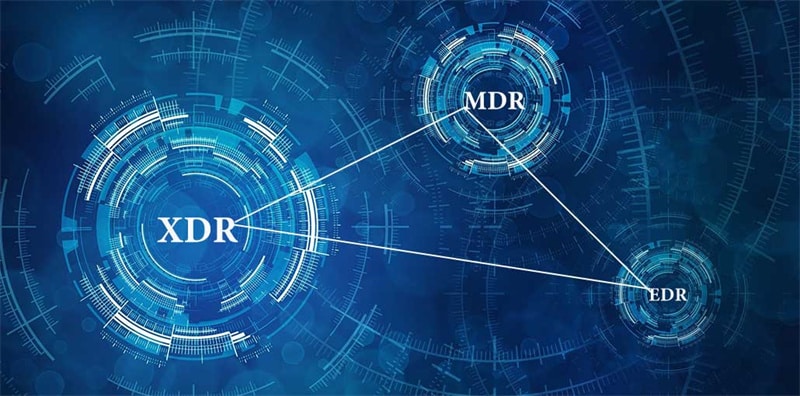
Time and time again, high-profile data breaches have brought cybersecurity to the forefront of business owners’ minds.
In today's digital age, a robust security strategy is essential for businesses of all sizes – from small startups to multinational corporations. Even with devoted resources put towards keeping your data safe, without an extended detection and response (XDR) in place, you may not be as secure as you think.
XDR takes advanced threat monitoring beyond traditional technological safety measures to provide comprehensive security coverage that can help slash businesses’ attack surface area. Read on to learn more about how implementing XDR in your organization can give you protection from even zero-day attacks as well as other advantages it offers!
What Is XDR And Why Is It Important

In the ever-evolving landscape of cybersecurity, new threats are constantly emerging. That's why there's growing interest in XDR- Extended Detection and Response- a new approach to detecting and responding to threats. XDR allows businesses to consolidate data from multiple security tools into one unified platform, providing better visibility and faster response times.
Given the increase in the sophistication of cyber-attacks, businesses need a solution that can keep pace. XDR is that solution. It not only cuts down on alert fatigue but also helps organizations stay ahead of attackers. By taking a proactive stance, businesses can mitigate the risk of a breach before it happens.
In this day and age, cybersecurity cannot be an afterthought- it must be at the center of any well-rounded strategy. XDR is an essential tool for any business looking to stay protected in our digital age. With XDR security solutions teams can quickly identify suspicious activity, respond swiftly and accurately to threats, and prevent potential attacks before they occur.
It's a powerful tool that can help businesses protect their data and their customer’s information.
How Does XDR Help Protect Your Business
Cyber threats are a real concern for businesses of all sizes. That's why many companies are turning to XDR (Extended Detection and Response) to help protect themselves. XDR provides a holistic approach to threat detection by consolidating data from multiple sources and analyzing it for potential threats.
By doing so, XDR can detect threats that may have otherwise gone unnoticed, and provide insights that help organizations respond to potential threats quickly and effectively.
With real-time monitoring and analysis, XDR helps businesses stay one step ahead of cybercriminals and protect valuable data and resources. So, if you're looking to safeguard your business against cyber threats, it's worth considering XDR as a part of your cybersecurity strategy.
Tips For Implementing XDR In Your Existing Security Infrastructure
Implementing XDR into an existing security infrastructure can be a daunting task, however, with the right tips, it can be achieved smoothly. Firstly, it's important to understand your organization's needs and what XDR solution can fit into those needs. Secondly, ensure that your security team is trained on how to identify and respond to potential threats within the XDR solution. Thirdly, collaborate with your XDR vendor to integrate their solution with your existing security system to achieve an optimal outcome.
Lastly, regularly assess and adjust your XDR solution as new threats emerge. With these tips, you can effectively implement XDR into your security infrastructure and feel confident in the protection it provides.
The Advantages Of Cloud-based XDR Solutions
The advent of cloud technology has revolutionized the way businesses operate, and one of its biggest advantages is the ability to use cloud-based Extended Detection and Response (XDR) solutions. These solutions offer multiple benefits, including faster deployment, better scalability, and easier management.
By leveraging the cloud, businesses can easily and quickly deploy end-to-end security solutions that cover all endpoints and provide better protection against cyber threats. Moreover, cloud-based XDR solutions can identify and respond to sophisticated attacks in real-time, reducing the risk of data breaches and ensuring business continuity.
Cloud-based XDR solutions are a must-have for businesses that want to stay secure and resilient in a rapidly evolving digital landscape.
Best Practices For Monitoring And Managing XDR Systems
XDR systems are vital in ensuring that networks and devices are secure from cyber threats. However, monitoring and managing them can be a daunting task. To effectively manage XDR, there are some best practices that should be adhered to. Firstly, it's essential to have a centralized management system that allows for easy access and monitoring of XDR activities. Secondly, regular updates and patches should be maintained to keep the system secure from new and emerging threats. Thirdly, continuous monitoring and analysis of system activity should be carried out to identify and respond to any suspicious activity quickly.
Lastly, it's crucial to provide regular training and support to IT teams involved in managing XDR systems to keep them up-to-date with the latest trends and techniques in threat detection and response. By following these best practices, organizations can ensure the effective management of their XDR systems and safeguard their networks against security breaches.
Common Challenges Organizations Face When Using XDR

XDR, or Extended Detection and Response, is becoming increasingly popular among organizations as a way to address the ever-evolving threat landscape of cybersecurity. However, this technology comes with its own set of challenges. One common issue is the complexity of managing multiple data sources and the need for seamless integration. Additionally, the sheer volume of alerts generated can be overwhelming for security teams to sift through.
To overcome these challenges, organizations must ensure proper planning and implementation, choose a vendor with strong integration capabilities, and invest in advanced analytics and automation tools to help with alert prioritization and response. By addressing these challenges head-on, organizations can fully harness the power of XDR and protect their digital assets.
In conclusion, XDR is a powerful security technology that offers numerous advantages for businesses looking to strengthen their cybersecurity strategies.
Thanks to its ability to provide integrated visibility and analysis capabilities, XDR can be an integral part of an effective defense against the latest cyber threats. Furthermore, when deployed in the cloud, it amplifies these layers of defense with scalability, flexibility, and affordability.
While there are common challenges associated with achieving maximum efficiency from XDR solutions, with proper planning and maintenance they can help fortify your business against both known and unknown threats. With XDR’s abundance of benefits firmly established, organizations should not hesitate to assess their needs and build out a comprehensive system that meets their goals.










